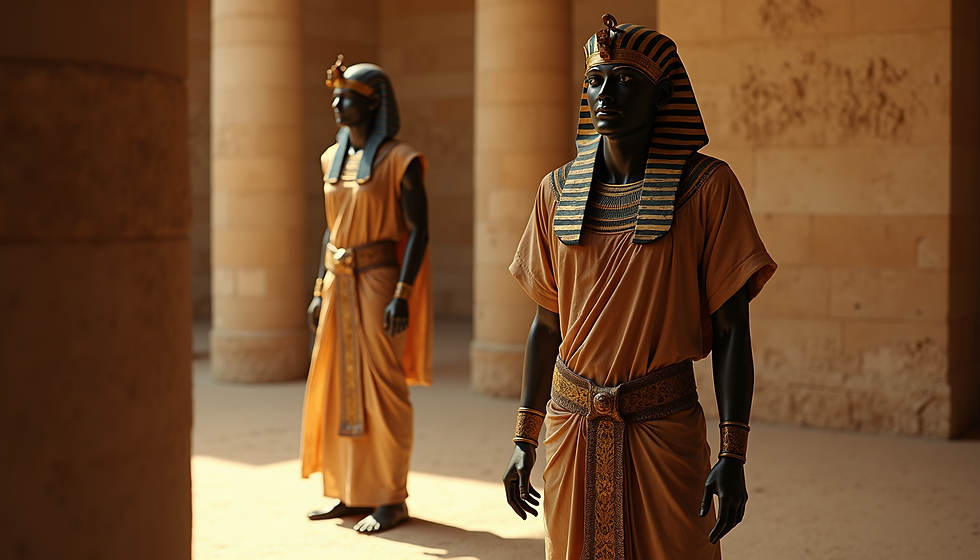Designs Inspired by Spirituality
- Snehes Dasgupta

- Jul 22
- 4 min read
The intersection of spirituality and design has rich historical roots and continues to evolve, reflecting how our understanding of self-development and personal growth has changed over time. This blog post will explore how designs inspired by spirituality have influenced dress from ancient traditions to modern concepts. By examining this journey, we can uncover the transformative power of spirituality and the way it shapes contemporary aesthetics.
The Historical Context of Spirituality
Spirituality dates back to ancient civilizations, where physical appearance was often a reflection of one's spiritual beliefs. Cultures across the globe adorned their bodies with various forms of dress, symbolizing devotion, status, and belief systems. For instance, in ancient Egypt, intricate jewelry and clothing served not only as adornment but also as protective amulets believed to provide a connection to the divine.

These practices illustrate that clothing was more than mere fabric; it was a medium through which people expressed their spirituality and identity. As we moved into the medieval period, religious garments became paramount, where the clergy wore specific robes that represented purity and holiness. Throughout history, the interplay between spirituality and design has been a dynamic one, continuing to evolve with societal changes.
Spirituality in Modern Design Concepts
Fast forward to today, spirituality has shed some of its ancient rigidity and transformed into a more inclusive journey of self-discovery. Modern designers are now integrating themes of love, compassion, and unity into their collections, deriving inspiration from ancient spiritual practices while maintaining a contemporary edge. This shift aligns with the modern approach to self-improvement, where clothing not only serves aesthetic purposes but also represents personal growth.
One example of contemporary clothing reflecting these values is the rise of athleisure. Activewear is not merely for physical activity; it embodies a lifestyle choice promoting health and well-being. Many brands infuse spiritual themes into their collections through fabrics designed for mindfulness and meditation. Clothes that help wearers feel empowered and connected to their inner selves are increasingly popular and widely accepted.

The Role of Inclusivity in Spiritual Designs
As spirituality has evolved, so has the understanding of inclusivity. Modern designs inspired by spirituality now embrace a wide array of identities, backgrounds, and experiences. This reflects a growing recognition of the need to create spaces that celebrate diversity and unity.
For instance, fashion brands that cater to different body types, gender identities, and cultural backgrounds have gained significant traction. This paradigm shift is crucial because it acknowledges the spiritual and emotional intersections within the fabric of humanity. Designers are now crafting items that do not only improve outward appearance but also promote acceptance and love.
A multitude of brands has emerged that advocates for body positivity while offering stylish and comfortable apparel — a classic example being the emergence of “size-inclusive” collections. These designs foster a sense of belonging, aiming to make everyone feel beautiful and connected.
The Influence of Nature on Spiritual Design
Nature has always played a pivotal role in spirituality, influencing designs that resonate with environmental consciousness. Many contemporary designers draw inspiration from natural elements, leading to collections that prioritize sustainable materials and ethical practices. This connection to nature enhances not only the aesthetic value of clothing but also underscores an important aspect of spirituality: harmony with the earth.
Consider the rise of eco-friendly fashion brands that fuse spirituality with sustainability. These labels use organic fabrics, dyes, and zero-waste practices to create clothing that reflects a deep respect for nature. This not only appeals to the consumer’s ethical sensibilities but also fosters a spiritual connection to the world around them.

Furthermore, incorporating natural motifs into designs—such as floral patterns and earthy tones—can evoke a sense of peace and grounding, bridging the gap between fashion and the individual’s inner journey.
The Future of Designs Inspired by Spirituality
Looking ahead, the integration of spirituality in design will continue to flourish as society evolves. Mindfulness and emotional intelligence are becoming mainstream concepts. This shift invites designers to blend aesthetics with deeper meanings that resonate with consumers on personal and spiritual levels.
For instance, wearable technology is becoming increasingly popular, offering not only convenience but also opportunities for mindfulness through features that promote intentional living. As this fusion of technology and spirituality unfolds, designers will have new avenues to explore in creating apparel that encourages self-reflection and personal growth.
As spirituality continues to redefine itself, the accompanying designs will likely echo these changes — emphasizing themes of unity, compassion, and self-improvement. The evolution of these principles, along with an acknowledgment of historical contexts, will shape the designs of tomorrow, offering consumers a powerful way to express their journey.
A Living Expression of Spirituality
In conclusion, designs inspired by spirituality encapsulate a journey that transcends time, bridging ancient practices with modern values. This delicate blend not only enhances aesthetics but also fosters self-discovery, personal growth, and inclusivity. As we embrace this evolution, it is vital to recognize the foundation laid by our ancestors while looking forward to a more inclusive and compassionate worldview.
Fashion and spirituality can walk hand in hand, creating spaces and expressions that allow individuals to feel connected — to themselves, the earth, and each other. With each stitch and fabric choice, designers hold the power to inspire love and unity, reflecting the essence of spirituality in a contemporary context.
The pathway through spiritual design is vibrant and alive, urging us to dive deeper into ourselves and nurture the compassion that connects us all.


Comments